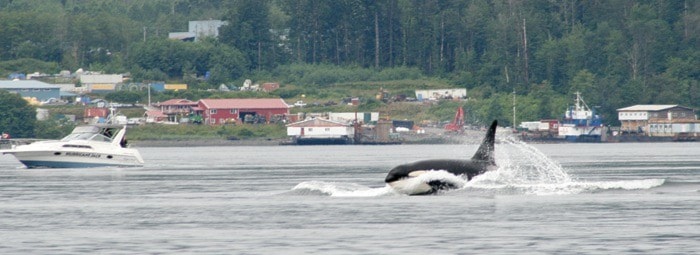Killer whales are an “iconic species,” says Roger McDonell of Stubbs Island Whale Watching.
People just love to see the magnificent black and white mammals travelling in pods, spy-hopping and breaching. And that’s a big thrill for some viewers who eagerly try to get closer and closer to get better photos or video.
“People get so excited around the whales that they throw all the rules out the window,” says McDonell, a former Campbell River mayor. “They continually ask, ‘can we get closer?’”
The short answer is “no” for the vast majority of conscientious whale companies on B.C.’s coast.
However, some boaters just can’t get close enough which violates federal guidelines and puts the operators at risk of being fined up to $100,000 for harassing a threatened species.
McDonell recalls filming whales from an adequate distance, just north of Campbell River, when a fishing guide zoomed by and got up really close to the pod of orcas so the client could get better photos with his cell phone.
McDonell wasn’t impressed so he sent the guide his photos of the close encounter and informed the guide he was in violation of the guidelines.
It’s a situation Aaron Webber of Campbell River Whale Watching and Grizzly Bear Tours has seen over and over again.
“I don’t think people are out there to harass them and maybe they don’t know they’re harassing them,” he said. “But I’ve been doing tours for over 13 years and I’ve definitely seen a change for the better. We try to set an example for others and maintain a safe distance away from whales. And what we see are boats lining up behind us. In the past they would drive right by to get closer.”
Close encounters can have tragic consequences for whales. Remember “Luna” the young killer whale that became separated from its pod and remained in Nootka Sound from 1999-2006?
Orcas are highly social and with no family around, Luna became friendly with boaters who were all too eager to return the friendship. The whale became a sort of pet for boaters who tossed in floats for Luna to fetch and return.
Luna became so friendly that he posed a danger to small boaters and, in the end, it determined his fate as well. In 2006, Luna died in the chop of a tugboat propellor.
“Some people just don’t realize what they’re doing,” says Webber.
Many whale watching companies also belong to the North Island Marine Stewardship Association. They work together to create safe practices for viewing whales and to equate the public.
One thing operators do when they spot whales is to hang a “slow down” flag, similar to a diving flag, in order to warn other boaters.
Public education is important, notes McDonell, because whale numbers appear to be increasing in the Inside Passage which will likely lead to more close encounters.
Near Telegraph Cove, where Stubbs Island Whale Watching is based, approximately 40-60 humpback whales regularly feed in the waters, and three humpbacks were feeding just south of Campbell River this past fall.
In the not-too-distant past, there were very few, if any, humpback sitings in the Inside Passage.
There’s also regular sitings of Pacific white-sided dolphins, grey and fin whales, the northern resident killer whale population has risen from 200 animals to just over 240, and there are more sitings of transient orcas which are feeding on the abundant year-round seal population.
“It’s a delicate process…and we understand the importance of giving (whales) space,” says McDonell. “We want people to enjoy the experience and we want them to do it in a way that doesn’t cause harm.”
For more information about whale watching guidelines, visit
www.wildwhales.org
